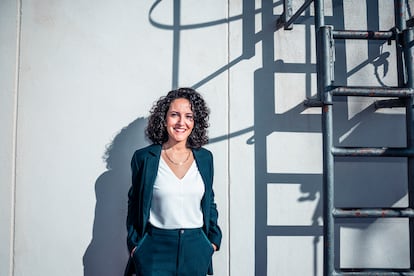
When María García (Teruel, 1987) was just a teenager from Teruel, that platform that claimed that her province also existed was in full swing: “We were isolated, there wasn’t a kilometer of motorway and this made me understand the importance of mobility. Without it there is no development”, explains the architect who has just been nominated among 1,200 candidates for the Design Europe award for a project of electric service stations, also called electrolineras, which designed for the company he works for Dutch Fastned, one of the largest providers of fast energy charging for electric cars on the continent. Smiling and prudent, he accepts difficult questions with the same grace with which he faces “problems”: “The most common is that batteries pollute. Nowadays 99 percent of them are reused and recycled and by changing very few materials it is possible to make them work perfectly again.” Defending electric mobility is a bit like being a vegetarian: always pay attention to impertinence. “I’m actually a vegetarian,” she says, laughing.
Ask. Electric mobility has always been associated with very positive values, sustainability, cleanliness and beauty. Has Elon Musk’s arrival at the White House changed the situation?
Answer. Its role in politics has influenced the image of electric mobility in general, but it remains the only one that can be 100% sustainable and that must not be overshadowed by politics.
Q. But do you know that when someone sees a Tesla now they no longer feel like they did three years ago?
R. And I think it’s good that society reacts, but if we abstract or distance ourselves, that doesn’t change the reality of electric mobility as a much better alternative to combustion mobility.
Q. When the blackout occurred, did you think “our reputation was going down the drain”?
R. I am very optimistic. I believe in progress. Ultimately, this shows that the electricity system must also be able to meet all demand, not only from electric vehicle charging points, but also from data centers and so on. We have the opportunity to do it now and do it well. In order for not only sustainable mobility but also the entire country to reduce emissions, many pieces of the puzzle still need to be changed. Each of us is doing our part.
Q. He has lived in the Netherlands for twelve years. What did they teach you?
R. Their work culture is very different from the Spanish one, in terms of the trust your bosses give you from the first moment. I started there when I was 25 with a very high level of responsibility, which I don’t think I would have had here.
Q. After all, they invented capitalism.
R. They have very little fear of failing, of jumping into the pool and trying and learning by trying.
Q. It is true that the first democratic Spain was built by very young people and now it seems that it is difficult to give them responsibilities…
R. You have to learn from them. Being exposed to a culture that trusts that you can do it, even if it’s your first time, is something very powerful, which gives you a lot of energy and a lot of motivation to grow.
Q. Was it difficult for you to gain space because you are a woman?
R. I wouldn’t say it cost me my life, but there have been situations in such a male-dominated world where maybe it takes longer for your voice to be heard. In the end, my profile is very different from that of the sector: I am a woman and I am very young.
Q. But there is no such thing as a good age either, because when she gets older she will cast the shadow of being “an old woman”.
R. Well, in my company this doesn’t happen. In the Netherlands, women occupy positions of power in companies and we have 47% of the workforce being female. I have been part of the management team since I was 32 years old. It’s possible, but allied men are needed.
Q. What do you notice when you work at a B corporation?
R. It is clear that our internal objective is to control the pay gap, there are internal exercises to observe how we receive salaries and correct them if necessary. And then there are protocols to avoid harassment in the workplace.
Q. He enters a power station and there are three people. One is a taxi driver. Who are the other two?
R. The second could be a plumber, that is, a person who travels many kilometers and owns a commercial car, because soon his circulation in the city will also be limited. The third is a profile like mine, someone who works in a multinational, where they are also switching to electric fleets.
Q. You have an electric car. Have you ever regretted it as happens, according to studies, to fifty of its users?
R. I have been with him for many years now and have made very long trips, from Madrid to Bilbao or Amsterdam. What happens is that today we still need to plan, obviously due to the issue of power stations…

Q. The atmosphere in one must be very different from that of a gas station.
R. This is exactly my job. Design and architecture can humanize a very technical space and make it very easy for users to understand how it works. Transforming spaces that have generally been industrial areas, car parks or non-places into green areas, with flowers, canopies with light, is the best part of this business.
Q. So I won’t find any tapes of ‘Los chunguitos’…
R. There is only one store in two of our locations, both in Belgium. They are spaces designed by us with much healthier products, much more ecological than those of a normal petrol station. It includes a picnic area and a children’s play area.
Q. If I say that power stations are elegant, am I being unfair?
R. It is true that not everyone has the purchasing power for an electric car, but it is something that will sooner or later extend to the entire population. The electric vehicle transforms 80%, the combustion vehicle only 20%. It’s like the steam train, it’s just a matter of time.





